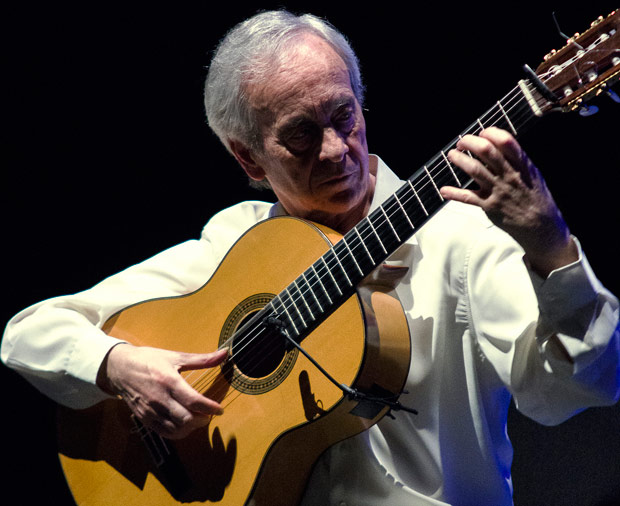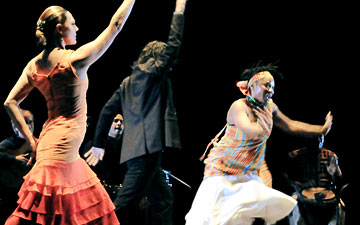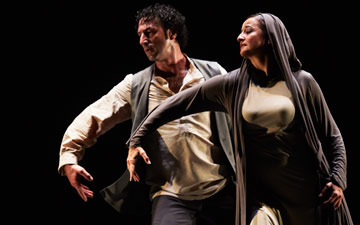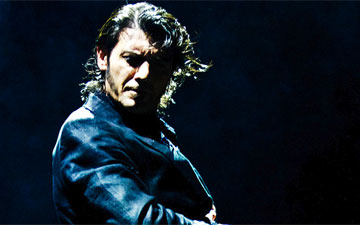
© and courtesy Paco Peña, Columbia Artists Management Inc. (Click image for larger version)
Paco Peña
Flamencura
New York, The Town Hall
20 November 2015
www.pacopena.com
thetownhall.org
All in the Family
Flamenco has undergone every possible transformation over the last century, from intimate café concert show to vulgar spectacle to personal laboratory of experimentation. It seems that every dancer and choreographer has a different idea of what flamenco can and should be. Then you see a show like Paco Peña’s Flamencura and everything else just falls away. Flamencura reminds us of what is most essential and most exciting about flamenco: the interplay between music and dance.
Peña’s show, which came to the The Town Hall for a single performance, uses an extremely spare model – flamenco performance as family gathering. Onstage, in a semi-circle, sit three guitarists, two singers and a man playing a cajón, or wooden box. Two dancers take turns in solo numbers, or, in a few cases, share the stage, more or less intimately. What brings the formula to life is the participants’ ability to forge an alchemic connection, to move beyond technique and skill into a zone of play. At one point during tonight’s performance the singer Inmaculada Rivero and the dancer Ángel Muñoz stood face to face, arms thrown open; it felt like a declaration of love.
Paco Peña, a musician who can spin endless stories with his instrument, is the heart of the enterprise; it is his musical integrity that anchors the group, providing a necessary counterweight to the flamboyance of Muñoz. It goes without saying that Peña is a wizard of the guitar, the recipient of countless honors, a player of infinite subtlety and clarity, and an artist who resists showiness at all costs. He is undemonstrative; during his solos, the eye gives way to the ear as he invites the listener into his sound world. Folk melodies emerge and disappear, one tonality melts into the next; there is always a sense of momentum, of purpose, to his playing, but his trajectory is circuitous and endlessly varied. He is also a generous and happy collaborator, melting into the ensemble to support a singer or dancer.
One of the high points of the evening’s performance was a duet for Peña and Muñoz that felt like a private conversation. Normally, Muñoz is a dancer of enormous bluster. But not here. The two finished each other’s sentences and answered each other’s questions, achieving a striking similarity of musical texture. For most of the piece, the dynamic range lay somewhere between piano and pianissimo. The two seemed bent on discovering just how quiet they could be without sacrificing clarity. Muñoz’s feet fluttered, Peña’s fingers scrambled across the strings. Then, as the tension mounted, they began to riff off of each other, interjecting, retorting. The audience held its breath until finally someone cried out, “pero que arte!” What skill!
This was followed by a two-part solo for Yolanda Osuna Linares, performed in a beautiful orange-colored dress with a train (bata de cola) and a fringed shawl (mantón). In her raspy, almost manly voice, Rivero sang a song about springtime love (“Enamorao”) as Linares whipped and kicked the long train of her dress like a tail, while simultaneously tossing and flipping her shawl. She became an ecstatic blur of ruffles and bright colors. Linares is a more disciplined performer than Muñoz, less of a showboat – though her zapateado is no less quick or subtle. Here, though, she lost the whiff of formality that clung to her other solos, finding a happy midpoint between precision and abandon.
In the first half of the evening the two had shared a dramatic duet in which Linares wore a black veil, like an apparition. She called Muñoz to her; he partnered her, holding her sides in a hungry embrace. They led eachother across the stage like Orpheus and Eurydice, though at times it was unclear who was following whom. Things did not end well. A happier balance was found in Muñoz’s climactic solo during the evening’s final stretch, a pure dance number in which he addressed each musician in turn. They played for him; he danced for them, diving and gliding, covering the length of the stage in two or three steps, sliding and tipping, pretending to fall, only to recover just inches from the ground. (He never seems to do the same thing twice.) At times he would pause, listening and preparing to catch the next wave. It was during this number that he and the singer faced off with open arms.
By then Muñoz had lost any reserve he might have displayed earlier in the evening. He shook his shoulders, whipping the audience into a frenzy. And yes, he milked things a bit, smiling broadly, raising his arms toward the heavens and bowing before sauntering off the stage. A momentary and forgivable lapse of taste in a thrilling night of flamenco. Paco Peña needs to come to New York more often, and stay longer.

















You must be logged in to post a comment.